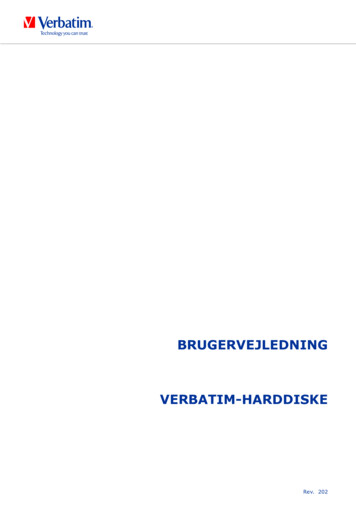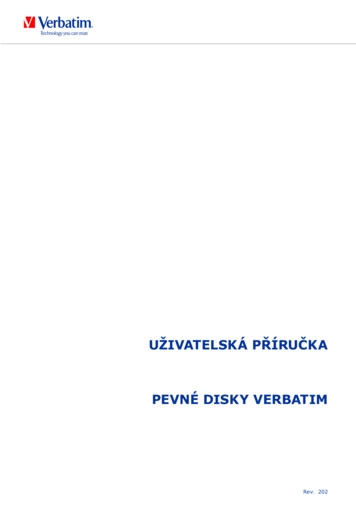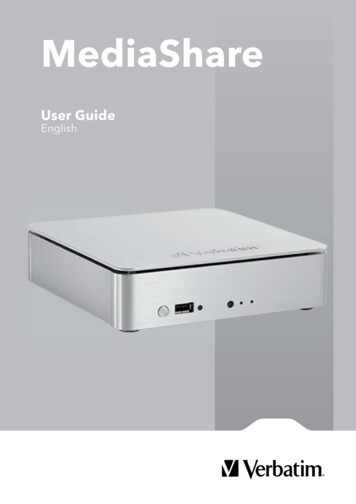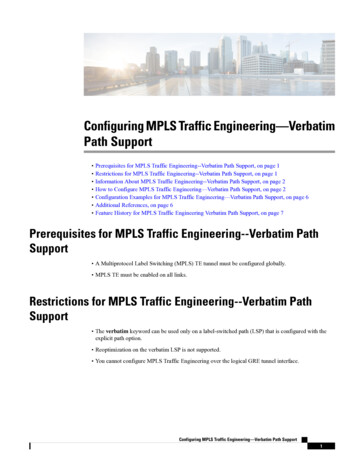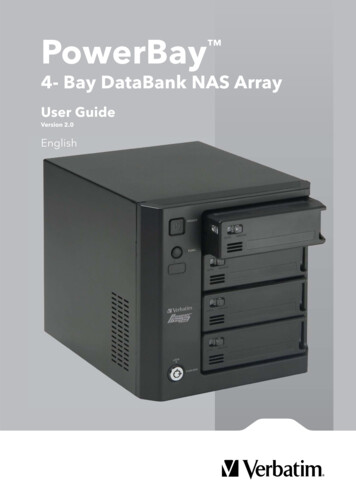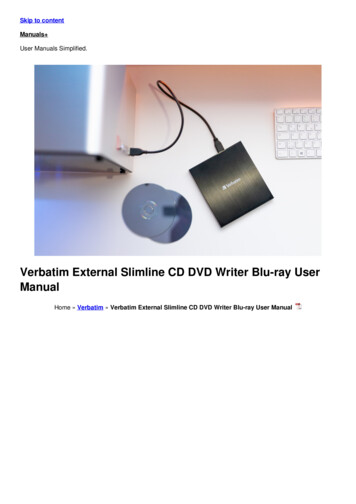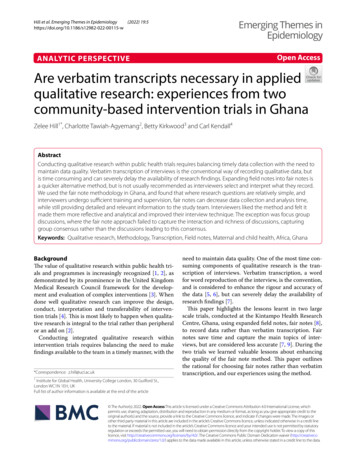
Transcription
Emerging Themes inEpidemiology(2022) 19:5Hill et al. Emerging Themes in 15-wOpen AccessANALYTIC PERSPECTIVEAre verbatim transcripts necessary in appliedqualitative research: experiences from twocommunity‑based intervention trials in GhanaZelee Hill1*, Charlotte Tawiah‑Agyemang2, Betty Kirkwood3 and Carl Kendall4AbstractConducting qualitative research within public health trials requires balancing timely data collection with the need tomaintain data quality. Verbatim transcription of interviews is the conventional way of recording qualitative data, butis time consuming and can severely delay the availability of research findings. Expanding field notes into fair notes isa quicker alternative method, but is not usually recommended as interviewers select and interpret what they record.We used the fair note methodology in Ghana, and found that where research questions are relatively simple, andinterviewers undergo sufficient training and supervision, fair notes can decrease data collection and analysis time,while still providing detailed and relevant information to the study team. Interviewers liked the method and felt itmade them more reflective and analytical and improved their interview technique. The exception was focus groupdiscussions, where the fair note approach failed to capture the interaction and richness of discussions, capturinggroup consensus rather than the discussions leading to this consensus.Keywords: Qualitative research, Methodology, Transcription, Field notes, Maternal and child health, Africa, GhanaBackgroundThe value of qualitative research within public health trials and programmes is increasingly recognized [1, 2], asdemonstrated by its prominence in the United KingdomMedical Research Council framework for the development and evaluation of complex interventions [3]. Whendone well qualitative research can improve the design,conduct, interpretation and transferability of intervention trials [4]. This is most likely to happen when qualitative research is integral to the trial rather than peripheralor an add on [2].Conducting integrated qualitative research withinintervention trials requires balancing the need to makefindings available to the team in a timely manner, with the*Correspondence: z.hill@ucl.ac.uk1Institute for Global Health, University College London, 30 Guilford St.,London WC1N 1EH, UKFull list of author information is available at the end of the articleneed to maintain data quality. One of the most time consuming components of qualitative research is the transcription of interviews. Verbatim transcription, a wordfor word reproduction of the interview, is the convention,and is considered to enhance the rigour and accuracy ofthe data [5, 6], but can severely delay the availability ofresearch findings [7].This paper highlights the lessons learnt in two largescale trials, conducted at the Kintampo Health ResearchCentre, Ghana, using expanded field notes, fair notes [8],to record data rather than verbatim transcription. Fairnotes save time and capture the main topics of interviews, but are considered less accurate [7, 9]. During thetwo trials we learned valuable lessons about enhancingthe quality of the fair note method. This paper outlinesthe rational for choosing fair notes rather than verbatimtranscription, and our experiences using the method. The Author(s) 2022. Open Access This article is licensed under a Creative Commons Attribution 4.0 International License, whichpermits use, sharing, adaptation, distribution and reproduction in any medium or format, as long as you give appropriate credit to theoriginal author(s) and the source, provide a link to the Creative Commons licence, and indicate if changes were made. The images orother third party material in this article are included in the article’s Creative Commons licence, unless indicated otherwise in a credit lineto the material. If material is not included in the article’s Creative Commons licence and your intended use is not permitted by statutoryregulation or exceeds the permitted use, you will need to obtain permission directly from the copyright holder. To view a copy of thislicence, visit http:// creat iveco mmons. org/ licen ses/ by/4. 0/. The Creative Commons Public Domain Dedication waiver (http:// creat iveco mmons. org/ publi cdoma in/ zero/1. 0/) applies to the data made available in this article, unless otherwise stated in a credit line to the data.
Hill et al. Emerging Themes in Epidemiology(2022) 19:5Main textThe trials were conducted between 2000 and 2010. TheObaapvita trial tested the impact of Vitamin A supplementation on maternal mortality [10]; and the NewbornHome Intervention Trial (the Newhints trial) tested theimpact of home visits by community health workers onneonatal mortality [11]. Within these trials, qualitativeresearch was conducted prior to the trial to inform intervention design and data collection plans, and during thetrial to identify emerging implementation issues, and toconduct process evaluations to understand the reasonswhy the interventions were or were not successful. Inaddition, specific sub studies were conducted exploringissues such as informal abortions and women’s understanding of being in a trial. This qualitative work includedin-depth interviews, focus group discussions and trials ofimproved practice and resulted in eleven peer-reviewedarticles [12–23]. The core qualitative data collectionmethods are shown in Table 1. In many cases these qualitative data were complemented by quantitative data.Rationale for using fair notesWhen we planned the formative research to design thecommunication strategy to maximise compliance withweekly vitamin A/placebo capsules in the ObaapaVitAtrial, we were faced with a decision about how to recordinterview data. We had three choices: Audio record and take field notes during the interview, and use the audio recording to produce verbatim transcripts and the field notes to add non verbalcommunication and observations. Audio record and take field notes during the interview, and use the recording to expand the field notesinto fair notes. Take field notes during the interview and expand onthese into fair notes from memory [7].With the advent of portable audio recording equipmentverbatim transcription had replaced fair notes as the convention [24], and audio recording was advised if a fairnote approach was used [9]. However, the time demandsof transcription were problematic for the ObaapaVitAqualitative research team, who needed to deliver usabledata to the trial team within a few months. The simplicityand rapidity of fair notes was attractive, so the team compared these data recording methods according to sevencriteria as shown in Table 2.Table 2 shows that, although verbatim transcription isnot an error free objective replication of the interview, itis the most complete method of recording data. It captures the respondent’s language most accurately, andPage 2 of 8permits quality assurance for the content of the interview. However, the ObapaVitA team calculated that iftranscription was conducted by the interviewers, it wouldalmost triple the duration of the formative research,especially as the interviewers were not expert typists.This meant that contracting transcription out wouldbe the only feasible option to ensure that the formativeresearch was compatible with the trial timeline. As shownin Table 2 contracting transcription out is problematicbecause it introduces an additional potential source oferror into the analysis. It also means the research teamloses control of the transcription process, and the teamdoes not benefit from the analytical thinking that occursduring note-taking and transcription.The ObaapaVitA team opted for the fair notesapproach. This was mainly driven by time constraints,our relatively simple research questions, and a desireto keep data recording within the field team to enhancereflection and analytical thinking. Having decided on afield note approach we were faced with a choice of audiorecording the interviews and using the audio recordingsto expand the interviews, or using memory to expandthe interviews. At the time the recording equipmentavailable for the study was bulky, and the population wewere working with was not used to the equipment. Wewere worried that being recorded would make participants feel nervous and inhibited. Although we knew thataudio recording was recommended [9] we decided not torecord the interviews.Given the problems with expanding notes from memory that are outlined in Table 2, we planned for intensivetraining and supervision during data collection to helpensure important content was not lost, that the interviewers recorded the language of the participant as muchas possible, and to aid in reflective and analytical thinking. The next section describes our experiences and lessons learnt in implementing this approach first describingour experience using the approach with interviews inthe ObaapaVitA trial, the adaptation of the approach forthe Newhints trial, and finally our experience using theapproach for recording focus group discussions.Use of fair notes in the ObaapaVitA trialData were collected by five interviewers across the different rounds of qualitative research. During a 1 week training on qualitative methods and on the study we discussedwriting up using the fair notes method. This componentof the training focused on: The importance of the research for the trial andof the trial itself. This was included to motivate theinterviewers to write detailed fair notes.
Hill et al. Emerging Themes in Epidemiology(2022) 19:5Page 3 of 8Table 1 Description of the qualitative methods used in the trialsTrial name and aimsAims of qualitativedata collectionObaapaVitA trial toassess the effect ofweekly vitamin A supple‑mentation on maternalmortalityFormative research to2000inform trial designTopics included:– Factors affecting adop‑tion and adherence tocapsules– Communication anddistribution channelsQualitative interviews toexplore implementationissuesTopics included:– Perceptions of the trialand the capsules– Exploration of specificimplementation issuesQualitative interviews toinform trial closure plansTopics included:– Questions andconcerns about the trialendingNewhints trial to test theimpact of home visits bycommunity health work‑ers on neonatal mortalityYear of study Methods used (IDI-indepth interviewFGD—focus groupdiscussion)Data collection teamDuration and averageinterviews per day50 IDI and 6 FGD withwomen of reproductiveage30 IDI with husbands13 IDI with drug sellers,birth attendants andhealth workers3 interviewers and 2senior social scientists2 months, with 2 inter‑views a fieldworker perday2002–200884 FGD discussion withwomen of reproductiveage4 interviewers and 2senior social scientistsThroughout the trial with1 FGD per month20084 FGD with trial field‑3 interviewers and 1workers and 4 with com‑ senior social scientistmunity members2 months with 1 FGD perweekFormative research to2006–2007inform trial designTopics included:– Gaps in the knowledgeand practice of neonatalcare– Barriers and facilitatorsto behaviour change– Current role of com‑munity health workersand their potential todeliver the intervention25 birth narrativeswith recently deliveredwomen30 IDI and 2 FGDs withrecently delivered orpregnant women20 IDIs and 6 FGDs withbirth attendants andgrandmothers12 IDIs and 2 FGDs withhusbands16 IDI with communityhealth workers and 6with supervisorsTrials of improvedpractice with 5 recentlydelivered women5 interviewers and 1senior social scientist2 months, with 1.5interviews a fieldworkerper dayProcess evaluation tounderstands reasonswhy the interventionwas or was not suc‑cessfulTopics included:– Issues affecting cover‑age– Information providedduring home visits– Barriers and facilitatorsto behaviour change– Acceptability of theintervention64 IDIs with womenenrolled in Newhints23 IDIs with communityCHWs15 IDIs with Healthworkers20 IDIs with traditionalbirth attendants3 interviewers and 1senior social scientists2 months with 3 inter‑views a fieldworker perday. Note interviews wererelatively short2010 The intent of each question on the interview guides,so that interviewers understood why the questionwas being asked and would be able to identify relevant interview content to include in their notes. The importance of capturing the voice of the participants rather than their own voice, but that fairnotes should say ‘she said that she went to the shop ’
Most complete method, although there may beequipment failures, poor equipment placement,environmental distractions, inaudible participants,deliberate alterations and transcription errorsAim is to capture respondents’ words and non-verbalcues accurately. In reality transcripts are representa‑tions of the interview and are selective, subjectiveand interpretiveRe-listening to the audio recording for clarificationand spot checking is possible, although spot check‑ing is rarely done in studiesCan be tiresome for the transcriber, leading to a lossof enthusiasm and can impact quality of transcriptToo much irrelevant detail may obscure key inter‑view content during analysisInterviewers, knowing that the audio recorder iscapturing the interview may tune out, and missimportant leads for managing the interviewTranscription process facilitates knowledge, under‑standing and interpretation of the data, and is bestdone by the interviewer. Due to time issues it isoften contracted out. This introduces an additionalinterpretation of the data into the analysisParticipants may feel nervous being recordedStudies focusing on dialogue and language; culturalthemes, or making detailed comparisons betweensegments of the populationSome researchers believe that transcription shouldalways be usedCompleteness [5–7, 27–36]Influence of interviewer/tran‑scribers views [24, 27–29, 31, 33,35–41]Quality assurance [5–7, 24, 35]Other quality issues [27, 34, 42]Who does it [5, 7, 24, 39, 40, 42]When is it best used [5–7, 9, 39]Not complete, and no ability to check for missingcontentContent may be recalled incorrectlyQuicker than both the other methodsField notes expanded from memoryRequires the most skill on the part of the interviewersNoneStudies focusing on thematic or content analysisStudies with simple research questionsthat do not require a high degree of closeness to the Where participants’ may be inhibited by beingdata; or that aim to get rapid feedback from targetrecordedpopulations to make programmatic decisionsDone by the interviewers as soon after the interview Done by the interviewers as soon after the interviewas possible, allows the recording of ideas that would as possible, allows the recording of ideas that wouldotherwise be lostotherwise be lostRe-listening to the audio recording for clarificationand spot checking is possibleExact words are not always captured and the writeHas the greatest potential for being selective,up represents the interviewers perspective. It can be subjective and interpretive and to lead to simplisticvery selective, subjective and interpretive. This caninterpretationslead to simplistic or interview centric interpretationsNot complete, but checking the audio recordingmeans less content is missedTime consuming and costly. 1 h of interview canRelatively quick. 1 h of interview can take 2–3 h totake 6–10 h to transcribe verbatim. The slow process write upcan disrupt iterationInclusion of repetitive or irrelevant discussionsincreases analysis timeHiring proficient typists may increase costsField notes expanded from audio recordingTime and cost [7, 9, 24, 26–28]Verbatim transcriptionTable 2 Comparison of different data recording methodsHill et al. Emerging Themes in Epidemiology(2022) 19:5Page 4 of 8
Hill et al. Emerging Themes in Epidemiology(2022) 19:5rather than ‘I went to the shop’ to be clear that it isnot a verbatim transcript. The importance of interviewers recording their ownthought and reflections, but that these should beclearly recorded in the fair notes using brackets [ .].The qualitative team then conducted several practice interviews, initially with each other, then with staffat Kintampo Health Research Centre and finally in thecommunity. The senior project researchers leading thetraining workshops observed the practice interviews.Interviewers completed practice fair notes and discussedthe notes line by line with a senior researcher. The interviewers then added to or changed their notes based onthe discussion. The research team then met as a whole toreview key lessons learnt about note taking and key findings from the interviews. During data collection we continued with one to one feedback and group discussions.Lessons learnt using fair notes in the ObaapaVitA trialThe practice interviews and write-ups identified threekey problems with the fair note approach: taking detailednotes during the interviews, ‘tidying up’ fair notes andwriting up brief fair notes.Interviewers initially took very detailed notes duringthe interview, as they were fearful of forgetting things.This impacted on rapport building with the participant and meant that interviews were overlong. Seniorresearchers worked with the interviewers to help themtrust their memories and interviewers practised takingconcise, less obtrusive notes. Interviewers found that ifthey wrote up their interviews as soon as they returnedto the field office, between 1 and 3 h after interviewswere completed, they could easily remember what wasdiscussed. This enhanced their confidence, reduced thelength of the notes they took during the interviews andalso increased the speed at which they wrote up theirinterviews. We developed a pattern of going to the fieldsites (1–2 h drive) early in the morning, conducting onaverage two interviews a day per fieldworker and thenreturning to the office to immediately start the write upwhich usually took the rest of the day. It was logisticallyeasier to conduct two interviews a day, but this meantthat interviewers had to rely more on their notes whenconverting the second interview into fair notes, whilst thewrite up of the first interview was always started between1 and 3 h of data collection.Interviewers wanted to make their fair notes read well,it was common for them to use technical terms that weknew were rarely used in the community. Whenever wesaw such terms we used it as an opportunity to discuss‘capturing the voice’ of the participant, for example wediscussed the term ‘high blood pressure’, and found thatPage 5 of 8the respondent had actually said ‘blood was up’. Throughthese discussions interviewers learnt that we were interested not just in what the participants said, but in capturing the words they used to say it.Initially, despite detailed field notes, the fair notes wererelatively brief summaries of the interviews, sometimeseven bullet points extracted from more complete fieldnotes taken during the interview. It took time for theinterviewers to determine what a good fair note shouldconsist of, this came through discussion and by askinginterviewers to read each others write-ups. Discussingthe intent of each question, and reviewing and discussing the fair notes, helped the interviewers understandthe content that we were interested in. For example, wewould read the fair notes and discuss why somethingwas important for the study, and whether the respondenthad said any more about the issue. Additional information would be added to the notes. We found that over oneto two weeks the interviewers became aware of important content and the fair notes became longer and moredetailed. We also found that the interviewers began tofeel less like interviewers applying an interview guide andmore like investigators—this enhanced the quality of thedata in that interviewers probed more and were morelikely to ask follow up questions on key issues, this wasan unanticipated advantage of the approach. Interviewers who had previously transcribed interviews, reportedthat writing fair notes made them more reflective abouttheir interviewing style, biases and perceptions and madethem think analytically. They reported that this madewriting up more enjoyable and enhanced their interviewing skills, they felt this increased their future employability and motivated them to do a good job.It was important that interviews were conducted,written up, reviewed and corrected the same day whenmemories were fresh. Initially the process was quite slow,but as confidence grew and feedback reduced in lengththe process sped up, and interviewers were conductingand writing up an average of two interviews a day. Thetime it took to get to this stage varied by data collectorbut on average it took around two weeks. Keeping theinterviewers motivated to complete quality write-upswas important. Senior researchers reviewing fair notesand going to the field with the interviewers showed thatthey cared about the study, and discussing findings madetheir use and importance clear. Interestingly interviewermotivation dipped at the same time data saturation wasreached, as the interviewers complained that they werenot learning new things and started to lose interest, thisdid not affect the quality of the fair notes, but interviewsbecame shorter with fewer probes which was addressedthrough the feedback loop. Using the fair notes method,the research took 8 weeks of high intensity work, with an
Hill et al. Emerging Themes in Epidemiology(2022) 19:5additional week of training. When the team reflected onthe experience we felt that collecting data intensely over ashort period of time enabled the interviewers to becomeimmersed in the topic and maintain interest compared toour previous experience with transcription.Adaptation of the approach for the Newhints trialFrom our experiences with the ObaapaVitA trialwe were satisfied that, given the type of qualitativeresearch questions asked within a trial, we could getuseful data using the fair note approach. Small andcompact recording devices had now become available to the study team, and the study population hadbecome used to devices such as mobile phones. Giventhese changes we decided that we should maintain thefair notes approach, but audio record the interviews toallow interviewers to check for missed content, checklanguage, to add key verbatim quotes and to allow forquality checks.Based on one of the senior researcher’s experiencewith using audio recordings to expand field notes (ZH),we encouraged interviewers to first write fair notes frommemory and then listen to the recording to check forcompleteness and to add key quotes-this was a quickprocess for the experienced interviewers with one hourof interview taking 1.5–2 h to write up. In practice mostof the interviewers found it difficult not to rely on theaudio recording, and despite several discussions almostall the interviewers listened to the recording and wroteup their notes as they went, this was a slow process andmeant that interviewers could conduct and write up onlyone interview every day and a half. Data collection andanalysis for the formative component of Newhints trialtook longer per interviewer than for the ObaapaVitAtrial. It also meant that interviewers were less likely tocomplete their write up as soon as they returned to theoffice as they knew they had the audio recordings to relyon at a later date. This meant that, at times, interviewswere written up several days after the data were collected,which inhibited iterative data collection, interviewerreflection and disrupted the flow of the data collectionwrite up cycle.Using fair notes to record focus groups discussionsBoth trials used focus group discussions as one of thedata collection methods. Interviewers found these difficult to write up using the fair note method. They tendedto record group consensus rather than the discussionsthat led to consensus being reached. We did not learnmuch from this data collection method, as the data weretoo summarized and not at all rich compared to the indepth interview data. From the formative research for thePage 6 of 8ObaapaVitA trial, we realised that fair notes were not agood way of capturing focus group discussion data. Forsubsequent focus groups and for the Newhints trial allfocus groups discussions were audio recorded and transcribed verbatim. Focus groups were a much richer anda more useful data source in this study, compared with inthe ObaapaVitA trial, as the content and nuances of discussions were captured.ConclusionThis paper adds to the few papers that provide practicaladvice on fair notes and transcription within qualitative research [5]. We found, as have others, that whereresearch questions are relatively simple, and interviewers undergo sufficient training and supervision, fair notescan decrease data collection and analysis time [7, 9]. Fairnotes have been criticised for resulting in simplistic interpretations that underreport the participants’ words [7, 8],but we found that with training and supervision they canprovide detailed and relevant information to the studyteam, and can enhance the quality of interviews and analysis—which has not been previously reported. The exception was data collected through focus group discussions,which was very difficult to write up using the fair notesapproach. As others have found, writing up while memories are fresh is beneficial [25], however this may need tobe balanced with ensuring feasible fieldwork logistics.Researchers that plan to use the fair note method mustfactor training and timely supervision into timelines andstaff costs, as it can take a week of training and up totwo weeks of intensive supervision for data collectors tobecome proficient with the method. Using the fair noteapproach, allowed the team to iterate steps and findingsduring data collection and think reflectively and analytically. Interviewers reported that writing fair notesimproved their interviewing skills. Although the datawere rich and relevant, it may be that the completenessand accuracy of the data are low.Using audio recording to expand field notes allowedverbatim quotes to be added and the completenessof write-ups to be checked, and is recommended [9].However, we found that interviewers relied on the taperecordings, and that this increased the write-up timeand decreased reflection and analytical thinking. Thereis no consensus on how audio recording should be usedto write fair notes [5, 9]; our experience supports listening to the audio recording after the field notes have beenexpanded from memory, but this may face resistancefrom interviewers as the existence of the tape made thefieldworkers reluctant to rely on their memories.AcknowledgementsThe trials were both part of a long term collaboration between the KintampoHealth Research Centre (KHRC), Ghana Health Service and the London School
Hill et al. Emerging Themes in Epidemiology(2022) 19:5Page 7 of 8of Hygiene & Tropical Medicine. The authors would like to thank these col‑laborating partners for their support and gratefully acknowledge all membersof the qualitative research interview team and all those community memberswho generously gave their time and provided information needed to supportthe trials. Finally we thank the LSHTM Centre for Evaluation for funding thewriting workshop at which this paper was developed.9.Author contributionsZH drafted the text, which was reviewed by CTA, BK and CK. ZH, CTA and CKwere involved in the implementation of the fair note approach within the twotrials; BK was the principal investigator of both. All authors read and approvedthe final manuscript.11.FundingThis study was supported in part by a Paper Writing Grant to Professor BettyKirkwood from the Centre for Evaluation at the London School of Hygieneand Tropical Medicine, and by Bill and Melinda Gates Foundation grantsOPPGH5297 and OPP1138582 through the World Health Organisation. Thefunders had no role in the conceptualisation, writing or findings of this paper.10.12.13.Availability of data and materialsN/A.14.DeclarationsEthics approval and consent to participateN/A.15.Consent for publicationN/A.16.Competing interestsThe authors declare that they have no competing interests.17.Author details1Institute for Global Health, University College London, 30 Guilford St.,London WC1N 1EH, UK. 2 Kintampo Health Research Centre, P.O. Box 200, Kin‑tampo, Ghana. 3 London School of Hygiene & Tropical Medicine, Keppel Street,London WC1E 7HT, UK. 4 Department of Global Community Health and Behav‑ioral Sciences, Tulane University School of Public Health and Tropical Medicine,1440 Canal Street, Suite 2350, New Orleans, LA 70112, USA.18.19.20.Received: 18 October 2021 Accepted: 20 June 202221.References1. Cooper C, O’Cathain A, Hind D, Adamson J, Lawton J, Baird W. Conduct‑ing qualitative research within Clinical Trials Units: avoiding potentialpitfalls. Contemp Clin Trials. 2014;38:338–43.2. O’Cathain A, Goode J, Drabble SJ, Thomas KJ, Rudolph A, Hewison J.Getting added value from using qualitative research with randomizedcontrolled trials: a qualitative interview study. Trials. 2014;15:215.3. Campbell M, Fitzpatrick R, Haines A, Kinmonth AL, Sandercock P,Spiegelhalter D, Tyrer P. Framework for design and evaluation of complexinterventions to improve health. BMJ. 2000;321:694–6.4. O’Cathain A, Thomas KJ, Drabble SJ, Rudolph A, Hewison J. What canqualitative research do for randomised controlled trials? A systematicmapping review. BMJ Open. 2013. https:// doi. org/ 10. 1136/ bmjop en- 2013- 002889.5. Halcomb EJ, Davidson PM. Is verbatim transcription of interview dataalways necessary? Appl Nurs Res. 2006;19:38–42.6. MacLean LM, Meyer M, Estable A. Improving accuracy of transcripts inqualitative research. Qual Health Res. 2004;14:113–23.7. Bertrand JT, Brown JE, Ward VM. Techniques for analyzing focus groupdata. Eval Rev. 1992;16:198–209.8. Helitzer-Allen DL, Allen HA. The manual for targeted intervention resear
verbatim transcription had replaced fair notes as the con - vention [24], and audio recording was advised if a fair note approach was used [9]. However, the time demands of transcription were problematic for the ObaapaVitA qualitative research team, who needed to deliver usable data to the trial team within a few months. e simplicity
